How Slack Became an $16 Billion Business by Making Work Less Boring
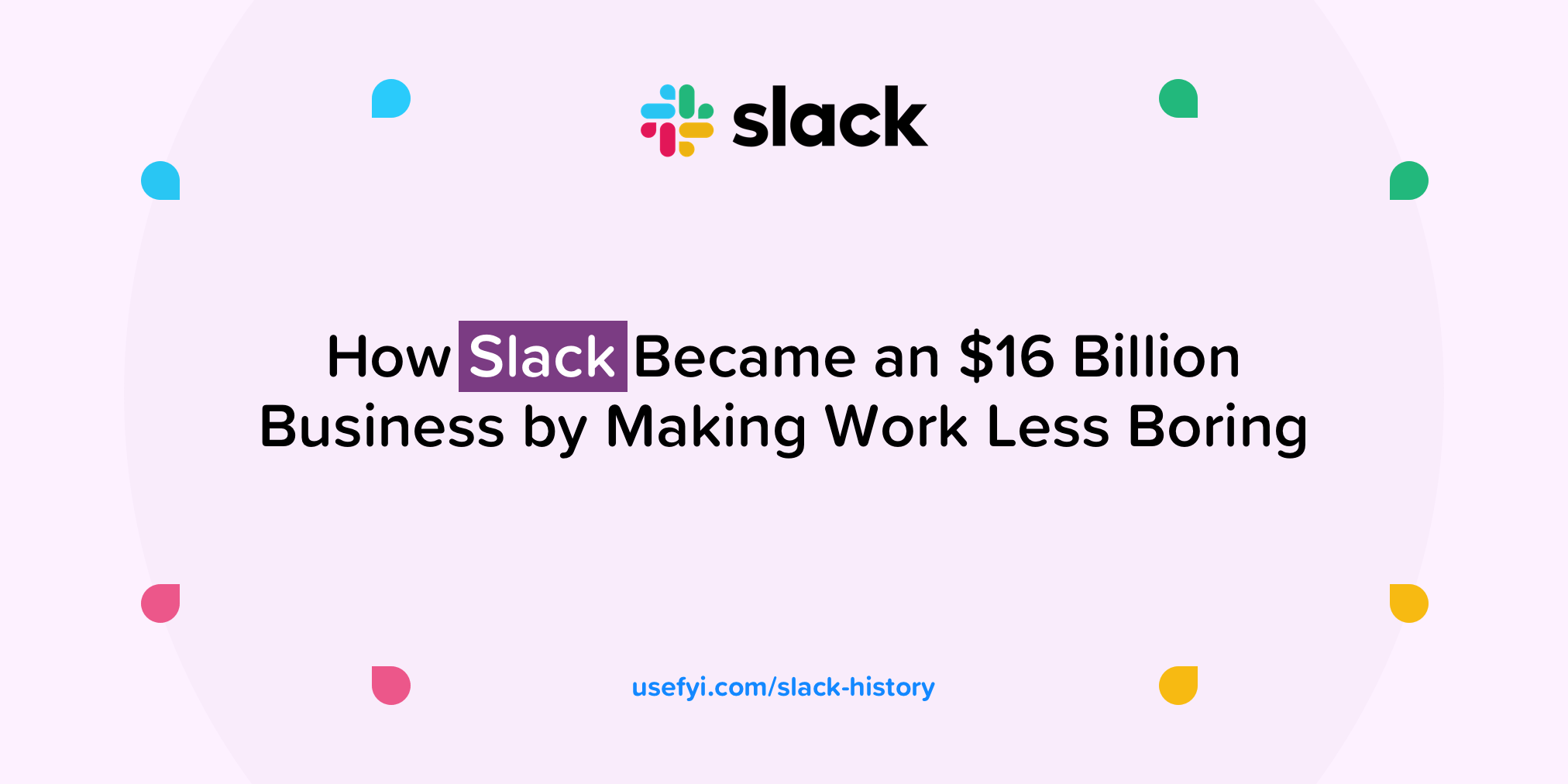
Slack isn’t just the fastest-growing SaaS startup in history. It also accomplished the seemingly impossible in just five short years: Slack made work fun.
Slack’s tagline is “Be Less Busy,” but for the first two years of Slack’s development, the company was very busy. What began as an internal tool hacked together out of necessity soon became the most popular chat and productivity tool in the world used by 77% of the Fortune 100. By testing Slack on its own development team over a prolonged period of time, the company knew exactly how people were using its product long before unveiling Slack to the world—a crucial competitive advantage that propelled Slack to unprecedented heights of success.
Let’s look at:
- How Slack was created out of necessity and allowed the company to pivot from a confused gaming product to a popular, profitable productivity tool
- How Slack’s understanding of how people used the tool before launching was a major strategic advantage
- Why building an ecosystem and platform around Slack was such a smart move
To understand how Slack came to be, we need to examine the circumstances surrounding its development—a curious tale that begins with a strange, failing video game.
2009-2013: The Death of Glitch and the Birth of Slack
Slack is famous for reaching a valuation of $1B after just eight months without spending a penny on traditional advertising or a Chief Marketing Officer. What most people don’t realize, however, is that Slack was a runaway success because it had a multi-year head start on everybody else. Slack founder Stewart Butterfield and his team set out to create something new and original for the massively multiplayer online role-playing game (MMORPG) market. As it turns out, they revolutionized how we communicate at work instead.
Being the fastest-growing startup in history isn’t the only thing that makes Slack unique. Its product development process was unorthodox. Slack was actually born out of a gaming company called Tiny Speck. Butterfield and his team didn’t intentionally set out to create a SaaS product for the workplace. They built a tool for themselves. They only realized their tool’s commercial potential later on.
Video game developers might not seem like the most logical group to make a sticky, engaging communications tool for today’s workplace, but Tiny Speck’s expertise in gaming was a major competitive advantage. Butterfield and his team already knew how to make repetitive tasks fun and engaging, as this is core to the gameplay experience of the MMORPG genre. Making work-based communication fun and engaging would be the secret sauce that made Slack so wildly successful.
Here are a few of the big things that happened for the company between 2010 and 2013:
- 2010: Tiny Speck raises $5M as part of its Series A round led by Accel Partners.
- 2011: Tiny Speck raises $10.7M as part of its Series B round led by Accel Partners and Andreessen Horowitz. Glitch launches officially on September 27. In late November, Glitch reverts to beta status so the team can work on several core improvements to the game.
- 2012: Glitch closes down because of the game’s failure to attract “an audience large enough to sustain itself.”
- 2013: Tiny Speck begins to develop Slack (an acronym for “Searchable Log of All Communication and Knowledge”) as a commercial product. By May, Slack is being used by around 45 companies in total. In August, Slack is released in a “preview release” beta period. The company deliberately avoids referring to its preview release as a beta, fearing that the term “beta” implies the product is buggy and unstable. Slack is released for desktop, iOS, and Android by the end of the year.
In 2009, Flickr co-founder Stewart Butterfield and his company, Tiny Speck, were hard at work on an MMORPG called Glitch.
Glitch was unlike any other MMORPG. For one, the game lacked combat mechanics. In a genre popularized by Blizzard Entertainment’s World of Warcraft and characterized by fantasy combat between warring factions, Glitch’s nonviolent approach was certainly unique. The game was set in a 2D fantasy world that takes place in the minds of 11 ancient, dreaming giants. Glitch’s surrealist landscapes, imaginative character designs, and extensive customization options were popular with the game’s small but loyal following. In Butterfield’s own words, Glitch was like “Monty Python crossed with Dr. Seuss on acid.”
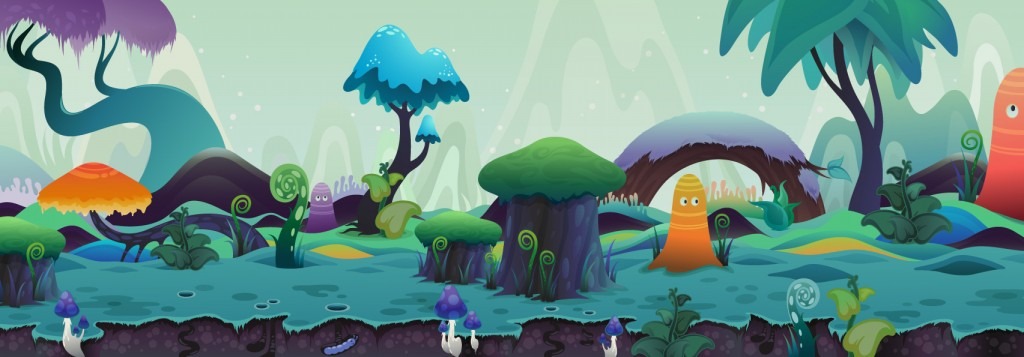
Tiny Speck wasn’t just a clever name for Butterfield’s company. The development team building Glitch consisted of just four people spread out across New York, San Francisco, and Vancouver. To overcome the challenges of communicating across multiple time zones, Butterfield and his team used Internet Relay Chat (better known as IRC), an online chat tool that was enormously popular in the late 1980s and early 1990s. IRC served Glitch’s developers fine—for a while. Before long, however, Butterfield and his team felt IRC was no longer up to the task. They needed something more.
That’s when they decided to start building their own communications tool.
It’s impossible to say with certainty when Tiny Speck began hacking together its internal “IRC-like” tool, which was originally called Linefeed. It’s possible that Butterfield and his team had a head start of up to two years before they unveiled their creation to the world. We do know, however, that development of the tool first began while the Tiny Speck team continued to work on Glitch.
At least initially, Butterfield had no plans to develop Tiny Speck’s internal chat tool as a commercial product. Instead, the team kept tweaking and improving its nascent communications tool as they worked on their game. New functionality was added on an ad-hoc basis. If a dev needed to share a design spec with a colleague, they built a function that could handle it. When it became clear that the team needed to be able to find old messages, they built an archive search tool.
Aside from introducing new features as they found a need for them, Butterfield and his team had two advantages when they began building their internal chat tool. First, although IRC was popular, it was still relatively difficult to use. To join an IRC channel, you had to first connect to a specific server, a process that didn’t always work. Second, IRC offered users an amazing degree of granularity when it came to adjusting settings. However, much of this advanced yet useful functionality was obscured by IRC’s old-school user interface, which made IRC’s learning curve comparatively steep even for tech-savvy users.
One of the biggest differentiators between what became Slack and IRC was that Butterfield and his team built their tool to be fully asynchronous. Users could log out and their messages would be waiting for them when they logged back in—something that wasn’t possible with IRC. Butterfield and his colleagues were old-school internet 1.0 folks. They knew what IRC did well. More importantly, though, they knew where IRC fell short. This would be much more valuable to their future product.
In 2010, Tiny Speck raised $5M as part of its Series A round, led by Accel Partners and Andreessen Horowitz. Tiny Speck was working toward a beta release of Glitch slated for December 2010, and Butterfield planned to use his Series A funding to expand the company’s operations in San Francisco and Vancouver. One year later, Tiny Speck raised a further $10.7M in its Series B round, again led by Accel Partners. Tiny Speck had raised almost $16M in just one year.
This spoke volumes about investor confidence in Butterfield’s leadership, the pedigree of his team, and the viability of Glitch as a product. Butterfield had already spun one popular business out of his game development endeavors—the image-sharing service Flickr, which Butterfield sold to Yahoo for an eye-popping $35M in 2005—and investors believed he could do it again.
Those hopes were dashed the following year in 2012 when development of Glitch was canceled.
In the blog post announcing Glitch’s imminent closure, Tiny Speck lamented the game’s failure to gain sufficient traction and new players. The game’s nonviolent, surrealist gameplay was popular among Glitch’s core audience but had very limited appeal among the broader MMORPG community precisely because the game intentionally defied the conventions of the genre. Attracting new users was not Glitch’s only problem, however. Glitch had been built using Adobe Flash, which had been popular in online game development for several years and was considered the industry standard at the time Glitch went into development.
By 2012, however, Flash was already falling out of favor. Flash was inextricably interwoven into every fabric of Glitch, from the game’s rendering engine to its networking code. With Glitch almost entirely dependent on Flash architecture, Butterfield and his team couldn’t port their browser-based game to any other platforms, severely limiting the game’s potential audience. At the time of Glitch’s closure, Tiny Speck had 45 full-time employees, and Butterfield went to remarkable lengths to try and find new jobs for his newly unemployed developers.
Glitch’s farewell post wasn’t all bad news, however. In an FAQ section that followed the closure announcement, Tiny Speck revealed that all was not lost. The company would not share Glitch’s fate.
“We have developed some unique messaging technology with applications outside of the gaming world and a smaller core team will be working to develop new products. But now is not the time to talk about that.”
It would be another six months before Tiny Speck unveiled its “unique messaging technology” with the world. When it did, it changed workplace communication forever.
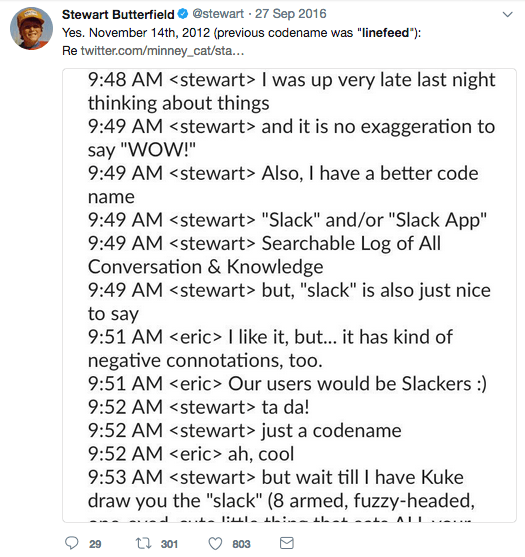
It’s unclear precisely when and how Butterfield made the decision to pivot from Glitch to what would later become Slack. What we do know for certain is that Tiny Speck began developing Slack in earnest in early 2013. By March, the company had a rough but functioning prototype of Slack that the team began using extensively.
However, while Tiny Speck was using Slack internally for several months, the team using it still consisted of just a handful of people. To keep improving the product, Tiny Speck needed more users. Butterfield and his team started asking around and calling in favors from friends at other companies including rental management software Cozy and music streaming service Rdio.
“We begged and cajoled our friends at other companies to try it out and give us feedback. We had maybe six to ten companies to start with that we found this way.” – Stewart Butterfield
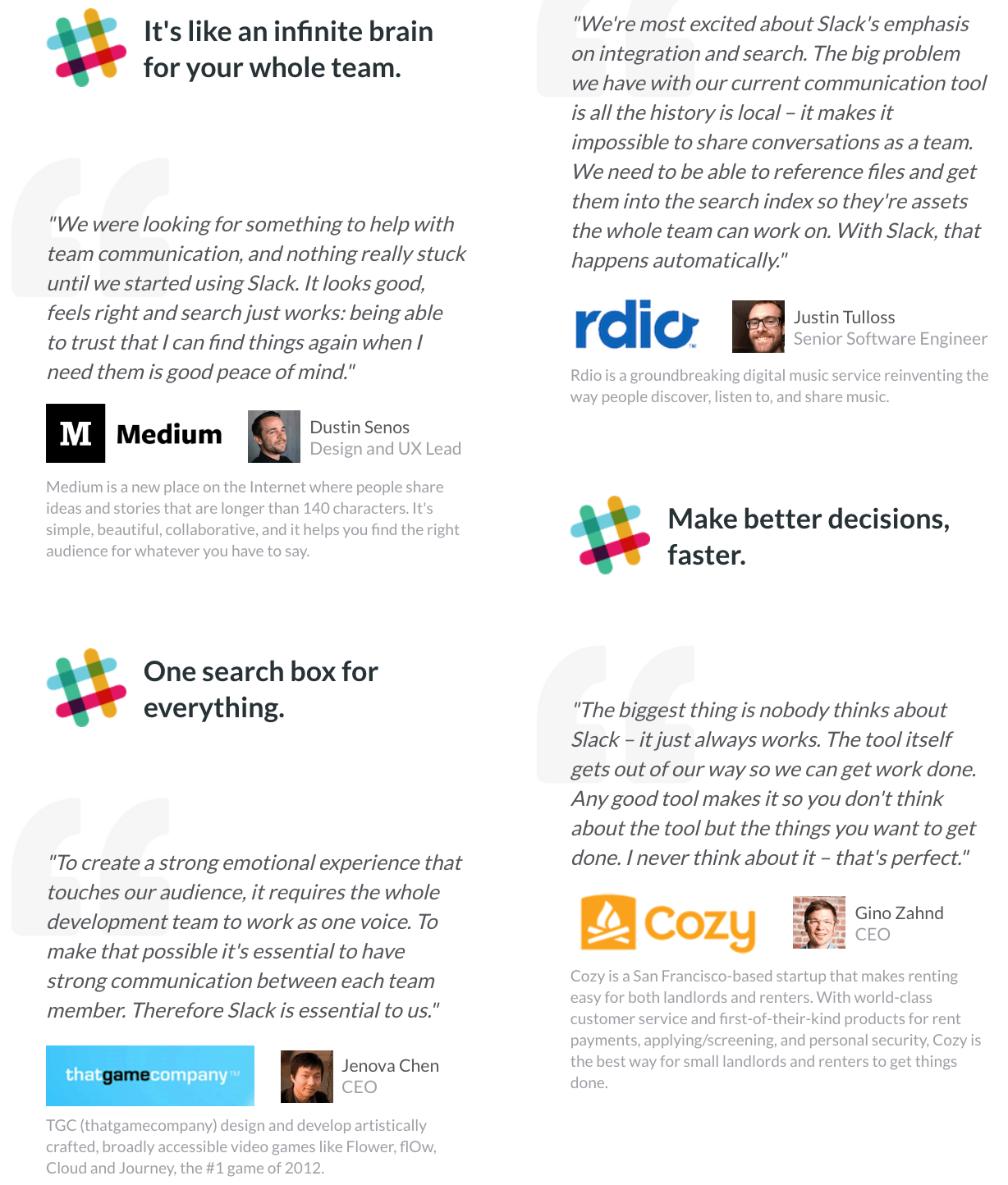
Butterfield quickly realized that although Slack had served his small team well internally, the dynamics and experience of using the product changed dramatically as the teams using the product grew larger. Functionality that worked fine in a small team of three or four became unwieldy among teams of 10 people or more. Butterfield and his team listened to the feedback of the early adopters carefully, tweaking and refining the product as they went.
Many startups focus all their energy on growing as rapidly as possible. By contrast, Slack focused on growing steadily. Each time the company received new feedback on Slack, they would not only address or implement changes based on that feedback, but they also invited more large teams to try the product. This iterative approach to development helped Tiny Speck build a solid product based on how people were actually using it and progressively expand its userbase.
There were two factors that made Slack practically irresistible:
- Transparency. Before Slack, there was no way for an employee to see what other people on other teams were working on, besides getting up and walking over to a colleague in another department. Slack changed all that by allowing teams to not only see what they were working on, but to access a lasting record of all communications surrounding projects, teams, and even entire departments.
- Centralization. The second element that made Slack so popular was that it simultaneously centralized communications while insulating users from distractions. Rather than using Slack to chat, Dropbox to share files, and Outlook to send email, users could now rely on Slack for all three of these functions. This eliminated the distraction of switching between multiple programs and limiting notifications to just one app.
Although much of the feedback that Slack evaluated was qualitative, Butterfield and his team didn’t ignore quantitative metrics. It didn’t take long for Butterfield to find his North Star metric: messages sent. 2,000 messages, to be precise. The Slack team knew that it took time for teams to start seeing Slack’s potential value. If users sent a certain number of messages through Slack—a total of 2,000 messages across an entire team—Butterfield and his developers knew with confidence that the team had really put Slack through its paces.
The real revelation, however, was when teams surpassed the 2,000 messages sent threshold, retention skyrocketed.
“For a team of around 50 people, that means about 10 hours’ worth of messages. For a typical team of 10 people, that’s maybe a week’s worth of messages. But it hit us that, regardless of any other factor, after 2,000 messages, 93% of those customers are still using Slack today.”
In May 2013, Slack was finally ready for its big reveal. Tiny Speck decided to brand Slack’s beta release as a “preview release” out of concern that the term beta implied the product would be buggy and unstable. Similar to Spotify, Slack opted for an invitation-only growth model. On the first day of Slack’s preview release, 8,000 people requested invitations to Slack. A week later, more than 15,000 people requested access.
Slack’s “preview release” wasn’t a beta. The product was essentially public at that point. They had spent time building Slack behind closed doors and away from prying eyes, giving them space to focus solely on the product. That period of early development was crucial to Slack’s early popularity and incredible initial growth.
Butterfield and his team knew Slack worked before they revealed it to the world, and they already knew a lot about how their customers were using the product. By the time Slack went into its preview release, the company was finally ready to start scaling aggressively.
2014-2016: Public Launch, Rapid Growth
Slack had taken its time to develop a strong product behind closed doors. By 2014, time was a luxury Slack could no longer afford if it hoped to maintain the momentum it had established. Slack needed more users—and it would attract them by leveraging the freemium model to expose it to as many people as possible.
Achieving ambitious growth wasn’t as straightforward for Slack as it was for other SaaS companies. Unlike similar products, Slack didn’t just have to convince individual users to try it out—the company had to convince entire teams. To further complicate matters, no two teams have the exact same needs. A feature that might be essential for one team might be completely superfluous to another.
Yet another challenge for Slack was overcoming individual objections. If eight engineers on a nine-person engineering team love Slack, but one lone holdout hates it, it’s highly unlikely that the team will adopt Slack. That critical weakness, combined with the unique pressures of selling Slack to entire teams rather than individuals, necessitated buy-in from everyone on a team. That meant carefully listening to all user feedback to ensure that the product was as useful—and sticky—as possible.
“For most companies, the hard thing is making the product work well enough to convince a single person at a time to switch to it. We have to convince a team, and no two teams are alike.”
Another complication Butterfield and his team faced was how people perceived chat messaging. According to Butterfield, roughly 20-30% of Slack’s users migrated to Slack from another messaging system, such as Campfire or HipChat. The remainder didn’t even see chat and messaging as a distinct category of software. Butterfield knew these users had to be using something to communicate internally, but they didn’t even know they needed a centralized communications system.
This was a significant hurdle for Slack to overcome, but it also represented a huge business opportunity. If Slack could not only create an entirely new category of B2B software but also position itself at the top of this new category, Slack could effectively seize an enormous share of an emerging market before anybody else.
- 2014: Slack launches publicly in February. In August, Tiny Speck officially changes its name to Slack Technologies. In April, Slack raises $42.8M as part of its Series C round led by Social Capital. In October, the company raises an additional $120M in its Series D round led by GV and Kleiner Perkins.
- 2015: Slack raises another $160M in its Series E round led by Social Capital. In March, Slack confirms that its central database was compromised in an attack on the company’s systems over a period of four days in February. In response, Slack introduced two-factor authentication and a password “kill switch” for team owners.
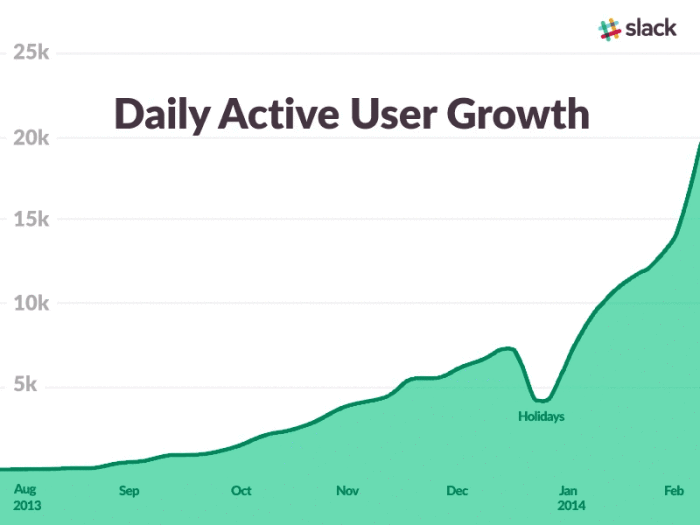
Slack officially launched publicly in February 2014. A few months later in August, Tiny Speck officially changed its name to Slack Technologies. In April 2014, just 10 weeks after its public launch, Slack raised $42.8M as part of its Series C round, led by Social Capital. At that time, Slack had more than 60,000 daily active users and 15,000 paid users just 10 weeks after existing its closed beta, all of which was entirely organic growth.
Slack had already attracted some heavy hitters in the media and tech industries, including BuzzFeed, Heroku, Medium, Lonely Planet, and SoundCloud, and the hype about Slack was spreading quickly, which accelerated growth even further. The company hoped to leverage this momentum and its Series C round to further expand its user base.
The key to Slack’s rapid, consistent growth was how the company approached adoption. Butterfield and his team were keenly aware of the difficulties in selling a product to teams as opposed to individuals. To combat this, they reduced as much friction as they could from the adoption process by virtually eliminating risk and keeping financial costs to the bare minimum.
If it was popular with a team, Slack’s paid plans were so inexpensive that managers could expense Slack just for their own team, even if the company wasn’t yet ready to adopt Slack at an organizational level. This made it easy for teams to use Slack for free, and there were just enough limitations in the freemium product to make Slack’s paid plans more enticing.
By October 2014, 30,000 teams were sending more than 200M messages via Slack every month. The company raised an additional $120M in its Series D round in October, led by Google Ventures and Kleiner Perkins Caufield & Byers. By this point, Slack had raised more than $180M—an amazing figure, considering the product had been out of beta for less than a year. Equally amazing was the pace of Slack’s growth.
What really sold investors on Slack, however, was the pace at which the company was converting free users to paid seats. By the time Slack entered its Series D round, Slack had more than 73,000 paying users—an increase of more than 386% in just six months—and more than $1M in monthly recurring revenue.
“As the leader of a brand-new product category, we have a huge advantage right now. These next 6 to 18 months are going to be critical for growth and this funding round gives us unlimited flexibility to ensure that Slack’s momentum will continue to pick up steam.” – Stewart Butterfield
From the beginning, Slack had listened carefully to its users, evaluating virtually all customer feedback. However, Slack wasn’t just listening to its users about product features. Unlike many startups, Slack already had a small customer experience team of three people working full time at launch to support new users. This wasn’t merely a ploy to increase retention, but another example of how Slack took the time to really nail the user experience to drive growth. By 2015, Slack’s customer experience team would grow to 18 full-time staff members, including six people offering 24/7 support via Twitter.
One aspect of Slack’s stellar growth from 2014 to 2015 that is almost always overlooked is the fact that Slack hadn’t just built a solid product—it had also built a solid brand around that product. Slack worked incredibly well, but the product’s success was just as much about fun as it was about function.
From the beginning, Slack had purposefully set out to create an experience that felt different than traditional email or IRC. In particular, Slack’s lively, colorful aesthetic set the product apart from the drab, utilitarian interfaces of competing products by companies like Microsoft. Slack’s designers wanted to create a unique visual brand that complemented how it felt to use the product itself.
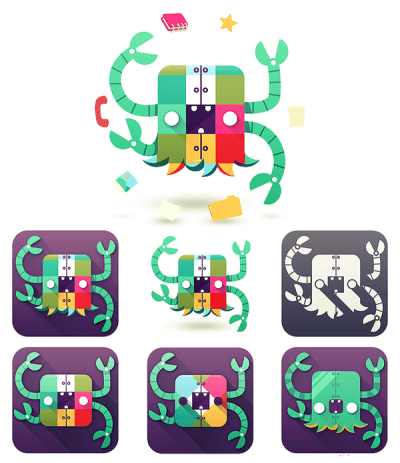
Everything about how Slack worked, looked, and felt defied conventional wisdom about enterprise communications tools. Slack’s interface was vivid and playful, unlike the dull grays and blues favored by legacy tools. Users weren’t restricted to text-based responses, and Slack’s support for emoji was immensely popular. Using Slack was fun—something even the best email client could never hope to be. Slack’s brandmark, the plaid hashtag icon, reflected the tool’s social sensibilities and served as a powerful gateway to the rest of Slack’s brand. Slack’s imperative tagline, “Be Less Busy,” perfectly captures the brand’s essence.
Even the product’s name is a cheeky, self-referential nod to the idea of goofing off at work while also serving as an active verb and an extension of the brand itself. Although Slack’s unique branding served as a key visual differentiator, it also served to further increase engagement. If using Slack was fun, people would be more likely to continue using it.
Slack wasn’t just a solid team communications tool—it was cool.
“Never before have we witnessed so much user love for an enterprise software platform. Life is a lot better with less email.” – John Doerr, Kleiner Perkins
However, aesthetics and emoji weren’t enough to maintain Slack’s ambitious growth trajectory. Slack was successfully attracting new users, but, as many businesses discover, retaining those users would be much more challenging than attracting them in the first place.
Slack approached user retention very cleverly in two ways. The first was to encourage user investment in Slack by leveraging the “Hooked Model”. With every action a user takes in Slack, they become more invested in the product. Every message sent, every file uploaded, and every gif response shared drives user buy-in. The more someone uses Slack, the more invested in it they become. This is, in part, what made 2,000 messages sent such a crucial metric early on in Slack’s development. Combine this gradual user buy-in with the intermittent reward of social validation from one’s peers, and Slack becomes increasingly addictive, significantly improving retention.
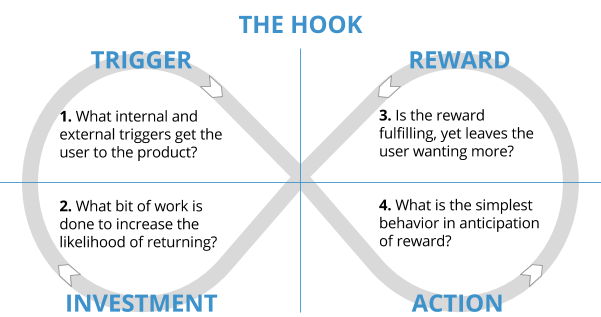
The second way Slack cleverly managed retention was to avoid gating premium features behind its paid plans. In contrast to other enterprise communications tools, there is almost no meaningful difference between Slack’s freemium tier and its paid product. The only real differences are the number of messages that can be indexed and searched, and how many integrations teams can connect to.
By making the vast majority of Slack’s functionality available to freemium users, Slack becomes significantly more appealing to small- to mid-sized teams interested in trying the product, while Slack’s inexpensive paid tiers made upgrading from freemium to a paid plan almost trivial from a cost perspective.
By April 2015, Slack was worth almost $3B. It had more than 750,000 daily active users, of whom 200,000 were paid users. The product had developed the kind of cult following that was unheard of for an enterprise communications tool. What Slack needed to do now was make the transition from a hip, niche software product to a mainstream part of corporate office culture.
To do this, Slack had to become more than just a product. It had to become a platform.
2016 – Present: Slack Goes Mainstream, Builds a Bot Ecosystem
By 2016, Slack had not only successfully created an entirely new category of software (at least in the eyes of many users) but also positioned itself at the forefront of this emerging market by making a product that delighted users. However, as Butterfield and his team soon learned, even an amazing product will only carry you so far. Everybody loves Slack. When people love something, they copy it.
Recognizing that hitting a saturation point was inevitable, Slack began to devise ways it could drive further growth without relying solely on user growth. In a somewhat ironic twist, it would do this by getting back to its Web 1.0 roots by allowing users to create custom bots, just as hardcore IRC users did back in the early ’90s.
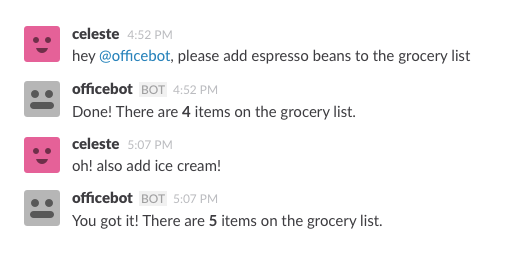
Slack had first experimented with bots shortly after its public launch in 2014. Finding himself in need of a way to take notes for later review, Butterfield began writing a program that would send his own notes as messages to a private channel that only Butterfield could access. This program became Slackbot, one of Slack’s most popular and commonly used functions. Butterfield later said that the idea for Slackbot came from the pet rock featured in Glitch, a friendly, helpful non-player character that offered players hints and tips on how to advance quests and navigate Glitch’s game world.
In hindsight, Slack’s transition from product to platform was inevitable. In 2016, however, the idea of Slack becoming a platform for automated bots was a decidedly risky proposition. On the one hand, Slack was giving users the ability to make Slack more extensible. On the other, this approach relied on people and companies to integrate with and build new products on top of Slack—something that was beyond Slack’s control. Despite the risks, Slack is betting big on its app and bot ecosystem. The company’s Slack Fund, an investment fund managed by Slack and some of the company’s leading investors, has already invested more than $80M to encourage the development of new bots, apps, and Slack integrations.
- 2016: In March, Slack introduces voice calling. The following month, Slack raises $200M as part of its Series F round led by Thrive Capital. In September, Slack is ranked #1 in Forbes’ Cloud 100 list. In October, Slack partners with IBM to apply the cognitive processing of IBM’s machine learning supercomputer Watson to Slack’s collaborative tools and bots, including Slackbot. In December, Slack rolls out video chat.
- 2017: In January, Slack introduces Threaded Messaging, a long-awaited feature that makes it easier to search and contribute to nested conversations across different channels. In September, Slack raises $250M as part of its Series G round led by SoftBank. Later that month, Slack announces native support for French, German, and Spanish language options. Shortly afterward, Slack introduces cross-company communication, another immensely popular feature.
- 2018: Having raised a total of $790M in VC funding and achieving a valuation of more than $5B, Slack names long-time employee Allen Shim as its first Chief Financial Officer.
Slack was already an enterprise powerhouse by the time it introduced voice calling in March 2016. However, although the introduction of features such as voice calling was almost inevitable, Slack was facing intensifying pressure from competing players such as Atlassian’s HipChat and Microsoft’s Teams product. The following month, Slack raised another $200M as part of its Series F round led by Thrive Capital. This brought Slack’s total VC funding to a breathtaking $540M and a valuation of $2.8B.
“As has always been the case, we are taking this opportunity to further secure our leadership position as we continue to execute on our ambitious growth plans.” – Stewart Butterfield
Slack seemed unstoppable, having increased its userbase by 3.5X between its Series E and F funding rounds. By April 2016, Slack had 2.7M daily active users, 800,000 paid users, and 430 employees. Progressively larger teams were relying on Slack for much of their internal communications, including global business intelligence publisher Dow Jones, the Federal Aviation Administration, and the U.S. State Department. Slack would end 2016 by introducing another new feature, video chat.
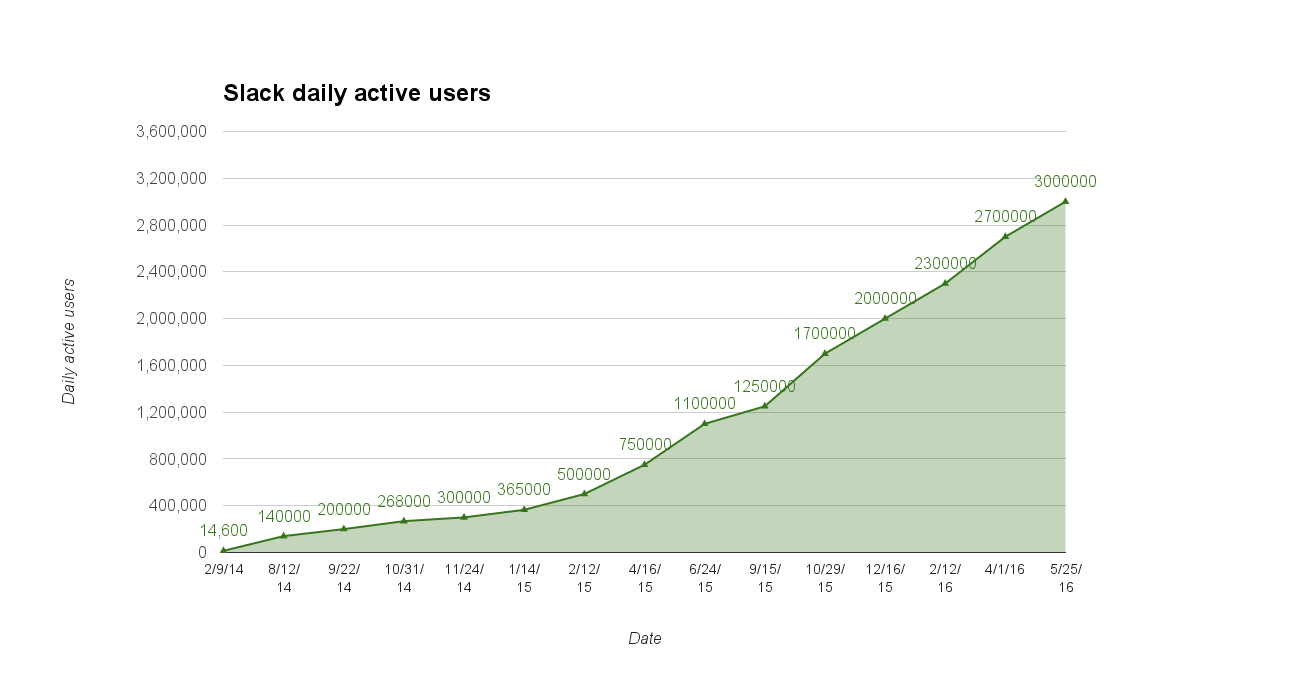
However, despite achieving stellar growth and amassing a legion of loyal fans, Slack still had a lot of work to do when it came to its core functionality. For one, the way messages were threaded left a great deal to be desired. Before Slack introduced its improved Threaded Messaging feature in January 2017, locating old messages wasn’t nearly as intuitive as it is today.
If users failed to create a Post (Slack’s old name for threaded conversations), they couldn’t do so at all after the fact. This meant it was significantly harder to find old messages, let alone comment on them. Even now, Slack’s threads lack some of the functionality users have come to know and love. Most slash commands still aren’t supported in threaded conversations, and you cannot add images to threaded replies (though you can use emoji). This isn’t just irritating—it’s a serious drawback for teams that rely on screenshots (such as customer support teams) or code snippets to communicate.
Many of the moves Slack made in 2016 and 2017 weren’t just about introducing expected product features. Slack had to shore up its dominant position in the market. Competing products such as Skype were never serious threats to Slack, but the company couldn’t risk allowing its competitors to jeopardize its growth. The full-page ad that Slack took out in The New York Times in 2016 welcoming Microsoft to the market—a cheeky wink to the ad Apple published mocking IBM in 1981—was a great example of Slack’s brand voice in action, but it also revealed that Slack wasn’t quite as bullet-proof as some might have thought.
Slack’s incredible growth streak continued throughout 2017, culminating in another stunning funding round in September when SoftBank funded Slack’s Series G round of $250M. The same month, Slack introduced support for French, German, and Spanish language options, further broadening its potential market beyond English-speaking regions. However, one of the biggest changes to Slack in 2017 was the introduction of functionality that allows users from different companies to join shared channels. For the first time, Slack users could chat with their own team and friends at other companies. This function was of limited utility from a business perspective, but it was immensely popular as a social networking feature.
In February 2018, Slack hired its first Chief Financial Officer, Allen Shim, one of the company’s longest-tenured employees. Shim’s appointment as CFO was as predictable as it was necessary. By the time Shim was promoted to CFO, Slack was worth more than $5B and had raised almost $800M in VC funding. It had more than 6M daily active users, more than 50,000 paid teams, and monthly recurring revenue of $200M.
“These changes show in our results and our readiness to take advantage of the opportunity ahead. We want to continue building a business that will serve our growing global user base for the long-term, and elevating Allen to CFO is a notable part of making that happen.” – Stewart Butterfield
In light of numbers like this, the question is not whether Slack will IPO, but when. Slack has achieved almost unimaginable success for an enterprise product, but its biggest challenge remains monetization beyond its paid plans. This is what made Slack’s transition from product to platform so clever. Slack has already achieved incredible growth, but creating an ecosystem of bots, apps, and integrations on top of its core product was brilliant. This provides Slack with the means to monetize beyond its core product and generate additional revenue streams.
Where Slack Can Go from Here
After achieving truly meteoric growth, Slack still has plenty of options. Where could Slack go from here?
A renewed focus on apps. One of the most exciting applications of Slack’s API that is currently in development is an access token system that will allow users to connect apps and integrations to entire teams or workspaces, rather than individual users. App-critical data isn’t isolated in silos, and there is the potential for permissions conflicts when data users leave teams.This isn’t just a logical extension of Slack’s existing functionality—it’s a potentially significant competitive advantage.
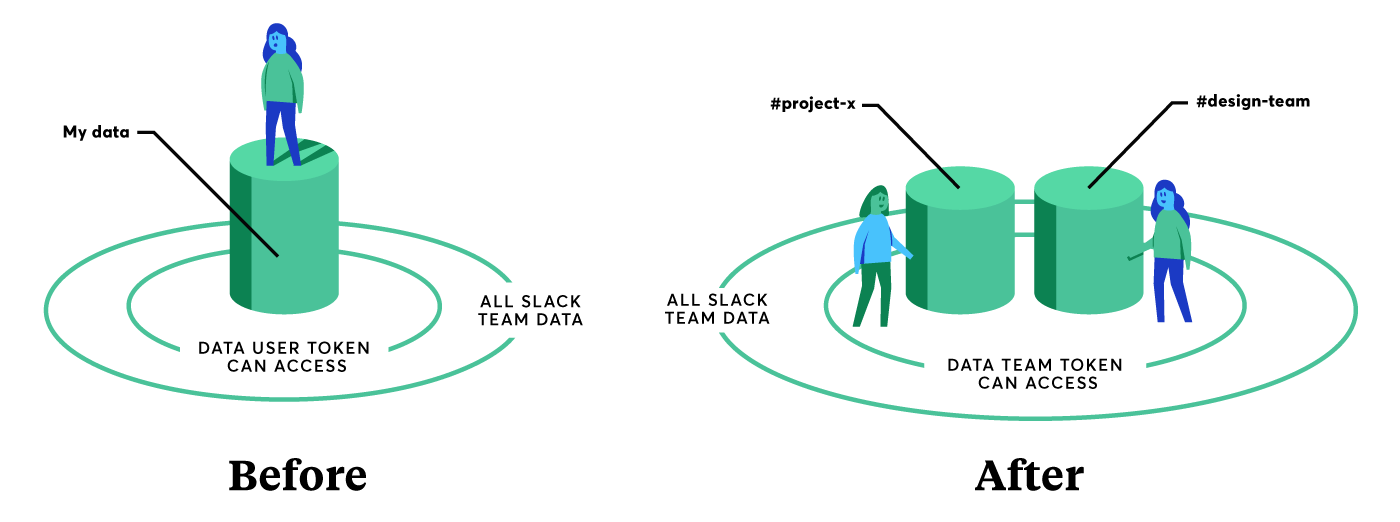
Another exciting development Slack is currently exploring is how teams access and interact with apps within existing workspaces. Slack is working on a new apps sub-menu in the main Slack sidebar that will take users to a dedicated space within Slack where they can learn more about how the apps work. This has enormous potential, as teams could effectively create entire learning resources on how to use apps without ever leaving Slack.
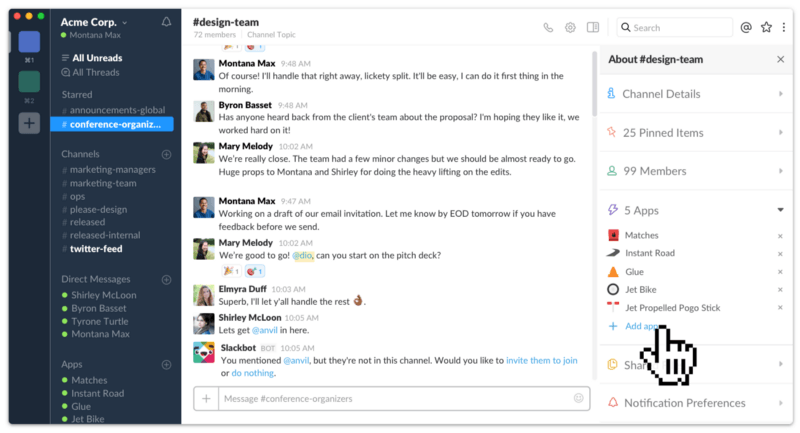
More bots, more AI, more intelligence. Slack recently held its first developer conference, Spec, in San Francisco. Apps took center stage at the conference, highlighting Slack’s commitment to further building its ecosystem around apps and integrations, but it’s Slack’s investment in machine learning and artificial intelligence that could reveal Slack’s future plans.Slack hired Noah Weiss, a former product manager at Google, in early 2016 to work on several AI projects. Since then, Weiss and his team have been working to integrate more AI functionality into Slack, particularly regarding intelligent filtering of notifications and updates. With more users comes more data, and Slack hopes that AI can help users distinguish the signal from the noise based on a concept Weiss calls the “work graph.”
Similar to Google’s Knowledge Graph, Slack’s work graph analyzes how Slack users within an organization interact with one another, where the majority of discussions among these groups take place, and which topics are most important. Weiss’ ultimate goal is to create AI-driven bots that are so intelligent they will serve as virtual assistants, helping Slack users prioritize their tasks and minimize non-essential chatter. It seems likely that Slack will remain committed to developing and integrating new bot and AI technologies in the future.
Renewed focus on the enterprise. Slack launched its Enterprise Grid in 2017. Dozens of the world’s largest companies rely on Slack’s Enterprise Grid, from Capital One to IBM. However, Slack cannot rest on its laurels if it hopes to maintain its competitive advantage over encroaching competitors like Microsoft and Facebook.For this reason, it’s logical that Slack would continue to develop its existing enterprise solution, including its range of specialized regulatory compliance offerings such as Slack’s HIPAA compliance product for healthcare organizations. Slack already has several new enterprise features in the works, including new security and administration controls, a Channel Administration function, and the forthcoming release of “unified workspaces.”
3 Lessons We Can Learn from Slack
Slack may be among the most mythical of Silicon Valley’s already legendary “unicorn startups,” but there are still plenty of lessons entrepreneurs can learn from Slack—without pinning all their hopes on inventing an entirely new category of B2B software.
1. It’s never too early to focus on your customers.
In the race to reach product-market fit or scale as quickly as possible, many startups fail to understand the value and importance of focusing on your customers from Day 1. This laser focus on how customers actually used Slack was fundamental to the company’s rapid initial growth.Take a look at your current product roadmap, then ask yourself the following questions:
Are you getting the information you need from your usage reports? Slack might not have acted on every single piece of feedback it received from early adopters—but it did evaluate almost all the feedback it received when developing its early product. Are you making the most of your usage data? Are you trying to convince users they need the new features you’re building, or are you giving your users what they’ve told you they want?
Is the messaging surrounding your product prescriptive or responsive? Put another way, who’s really driving the development of your product—you, or your users? Early on, Slack spent months really examining how its users were interacting with early builds of the product—and this was after a year or more of the Slack team eating their own dog food. This responsive approach to product development allowed Slack to quickly iterate on user feedback as it grew, which, in turn, allowed it to invite progressively larger teams to try the product as it improved.
Are you “married” to unpopular features? One trap I’ve seen countless entrepreneurs fall into over the years is the sunk-cost fallacy. They spend months (or even years) developing an unpopular product or feature only to find they cannot let the idea go due to how much time, money, and energy they’ve already sunk into the project. Focusing on the wrong features is very dangerous. Not only does it waste precious resources such as time, money, and man-hours, it can also alienate your users who may not even care about the features you’re preoccupied with. Are you really developing the right features and addressing the right user problems?
2. Know when to pivot.
Imagine if Butterfield and his team had forged ahead with Glitch instead of acknowledging the flaws in their project and moving onto something else. Slack would never have been built, and it’s a toss-up as to whether Butterfield’s company would have survived.If your product is struggling, it’s time to ask yourself some difficult questions.
Are your product’s problems intrinsic or extrinsic? Put another way, is the problem with your product (intrinsic) or a broader factor beyond your control, such as an oversaturated market (extrinsic)? Glitch failed because of lack of user growth—an intrinsic problem—but it also failed because Glitch relied on Flash, a losing bet in the never-ending format wars and an extrinsic problem. If your product is struggling because of intrinsic difficulties, you have more options, such as an organizational restructure or renewed focus on other aspects of the product. If your product’s problems are extrinsic, however, it might be time to start thinking hard about your next move.
How much of your current project is salvageable? When Tiny Speck shuttered Glitch in 2012, it had already built a functioning prototype of Slack that the company had been using internally. This made the decision to pivot from a failed gaming product to a commercial communications tool much easier. Take a look at your current product. Now let’s say your company is failing. How much—if anything—could be salvaged from your current product? Could any of your product’s more popular features work as standalone products?
How much of what you’ve learned could be applied to another venture? Butterfield and his team might not have set out to build an immensely popular workplace communications tool while they were building their surrealistic MMORPG. It was clear, however, that not only could Tiny Speck’s internal tool be further developed into a product with incredible commercial potential, but the company’s background as a video game developer proved instrumental in making Slack fun and how it went about actually building its product. How much of the institutional knowledge that’s been accumulated at your current venture could be applied to another business idea? If you can identify at least one or two things you could use to build a better product—and a more viable business—it might be easier to come to terms with knowing when to pivot.
3. Double-down on product.
Just as it’s never too early to start thinking about your customers, you should be relentlessly focused on developing the best possible product you can build. Slack didn’t just identify a gaping hole in the market—it also focused on making the very best possible product. Think about your product or service and ask yourself the following questions:
What features of your product do your users really love? For Slack, its extensive range of integrations, its list of commands, and its support for gifs and emoji replies are all beloved by Slack users. Which aspects of your product do you think people would be excited to show their friends? And how can you make these features even better/stickier?
How do people feel about your product and brand? Slack knew early on that the only way it was going to muscle in on a market dominated by large, legacy players like Atlassian and Microsoft would be to make the product—and the brand around the product—fun. How do people feel about your product and, by extension, your brand? Have you considered conducting sentiment analysis research to learn how people feel about your product?
Which aspects of your product are good enough to steal? Everybody loves Slack, so it was inevitable that many other companies would ape (or outright steal) features of Slack to incorporate into their own products. Which features of your product are good enough that another company might be tempted to “borrow” your idea? How can you make them even better—and protect yourself from imitators in the future?
Changing the Future of Work
Plenty of startups have promised to disrupt the world of work, but few have managed to do so quite as effectively—or quickly—as Slack. More than 6M people, 50,000 teams, and dozens of the world’s biggest and most profitable companies all rely on Slack to “Be Less Busy.” Now Slack’s biggest challenge is proving its indispensability beyond workplace chat, expanding into new and challenging markets, and further building out the ecosystem that rests upon Slack’s core product.

